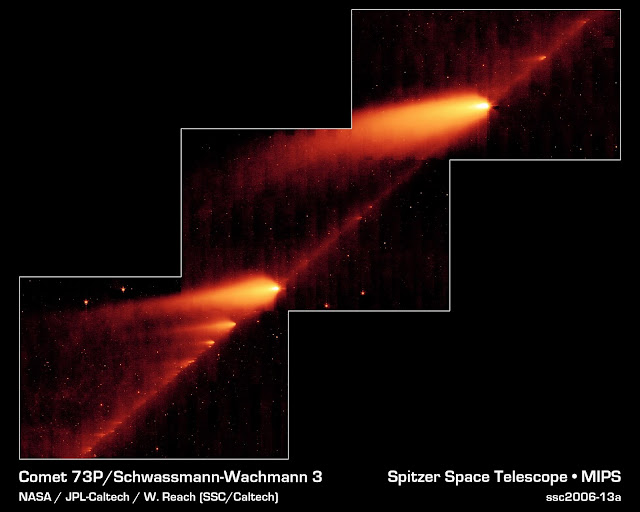The hazard from fragmenting comets
Last month, Bill Napier (co-creator of the coherent catastrophism theory, with Victor Clube) published his latest paper (MNRAS, vol. 488, p 1822-1827) on the impact hazard from disintegrating comets in the inner solar system. His focus is on a large 100 km comet in an Encke-like orbit. It is a sophisticated work that extends his earlier estimates, this time by combining explicit orbital simulations with a calibrated model of comet fragmentation (published by de Sisto et al. in 2009).
His aim, like mine in Prehistory Decoded, is to estimate the hazard to Earth from the kind of comet thought to have become trapped in our inner system a few tens of thousands of years ago. We know, pretty much, that this happened because of the massive zodiacal dust cloud and correlated fragments that remain in orbit.
He concludes that we can expect one or two impact collisions over the last 20,000 years, or so, with energy over 6000 Mt, and that this energy will likely be unevenly distributed across a hemispherical region. This is roughly 600 times the energy of the Tunguska impact, which itself was large enough to demolish one of our biggest modern-day cities (like Greater London).
This broadly supports my own estimates in Prehistory Decoded, based on simple fragmentation pathways and Opik's collision formula, where I find that we can expect one or two collisions with an energy of at least 10,000 Mt, and perhaps another ten with energy over 1,000 Mt, from the same sized comet over the same timescale. Great!
Actually, Bill's new work is quite conservative. His impact energy estimates are based on a typical swarm of 100 billion tonnes, and assume that a collision can only occur if a debris swarm is ejected from the giant progenitor comet when its orbit and Earth's orbit intersect (which occurs twice roughly every 3,000 years due to apsidal precession). But he shows in the same paper that, typically, a debris swarm will have a mass that is two or three times greater than this. And it is also true that collisions with a debris swarm can occur even if Earth's orbit and the giant comet's orbit don't exactly intersect, because the comet swarm can cover such a large area (thousands of times Earth's projected area). Overall, he probably underestimates the collision hazard by a factor of 10.
It follows, then, that my own estimates of the collision hazard in Prehistory Decoded are also underestimated.
The take-home message is that if the 'trapped' giant comet scenario is correct (as it almost certainly is), then we should expect to see calamities on the scale of the proposed Younger Dryas impact, as well as plenty of other somewhat smaller disasters, over the last few tens of thousands of years. Because of the giant comet's apsidal precession, most, but certainly not all, of these can be expected to fall within a high risk period of a few hundred years every 3,000 years.
The next period of higher-risk activity is expected around 3,000 AD.




This is the answer to Fermi's paradox. Civilizations don't develop the requisite technological capability to get off world fast enough before they're knocked back to a previous level of more primitive development.
ReplyDeleteYou mention Graham Hancock a couple of times in your videos on YouTube, and based on what you've said, and combined with your own theory on the ancient zodiac, I think that you take Hancock's conclusions rather seriously. With that in mind, what sort of scenario do you think unfolded in the distant past concerning the transmission of knowledge of the zodiac or of this proposed method of record or time keeping? It doesn't seem to me to be the kind of system that could have been independently developed by hunter gatherers over tens of thousands of years.
Interesting idea...
DeleteAs for discovery of precession of the equinoxes, I should think it could easily be discovered by ancient man. They would naturally have an interest in the seasons and the stars, and other objects in the sky. They were undoubtedly as smart as we are today. Over a person's lifetime, precession causes the stars to 'move' by 2 moon-widths. That would easily be noticeable if you were already carefully watching the stars to track the seasons.
Is it any idea about, if it was the energi in the impact that changed the ecology with the ice melting witch transformed the planets ecology to a more warm ecology and stabilized it there ? And how much energi was it? In that case, will it not mean that the sun is able to maintain the energi level in the ecology, not change it?
ReplyDeleteThe impact energy, although immense, is not large enough itself to have any noticeable effect on Earth's temperature/climate. The climate change probably results from two key processes. First, the impact could cause ice-dams to break, which allows huge glacial lakes to drain into the northern oceans. This cold salt-free water can then cause changes to ocean circulation currents which transport heat around the planet. Essentially, heat from the warm southern oceans is blocked from travelling north to warm the northern oceans. Second, dust from the impact can be lofted into the atmosphere, perhaps for several years. This blocks sunlight, causing a 'nuclear winter' effect. This can cause northern oceans to freeze and ice caps to advance. In turn, this can cause more sunlight to be reflected by the ice, and you get a positive feedback effect. The most detailed climate modelling studies suggest both mechanisms - cold meltwater and atmospheric dusting - to reproduce the sudden and dramatic climate change seen at the onset of the Younger Dryas.
Delete